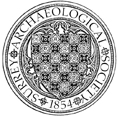Fifth and final season of excavation by Rob Poulton of SCAU for SCC, SyAS and others. A section across the early bailey ditch confirmed that it was infilled in the late 12th century; 13th century walls were found built over the northern edge of the ditch. The building known as Lord Edward’s Chamber (built in 1246) was examined and the finely moulded jambs of a doorway uncovered. The Chamber was found to be earlier in date than the adjoining building, which cannot, therefore, be the Almonry.
